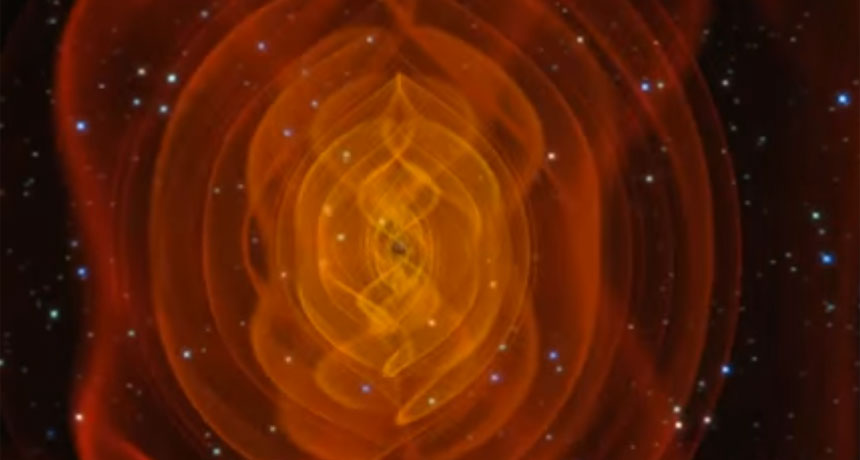Black hole smashup sent out ‘yottawatts’ of power
When two black holes collided, they released a mind-blowing amount of power in gravity waves

When two black holes collided, as an artist simulated here, a huge amount of power was released as gravitational waves. A really large amount of power.
Henze, NASA
A black hole collision, detected last September, served as the basis for confirming the existence of gravity waves. Scientists were only able to see those waves, or the effects they had on space-time, because they came from an explosion that blasted out such an intensely big amount of power. That energy is measured in watts. And the black-hole smashup released a mind-blowing amount.
The quantity is so big that it’s measured in yottawatts (YAHT-tuh-wahts).
A watt is defined as energy consumed at a rate of one joule per second. To get a picture of that, imagine an apple. The amount of energy it takes to lift the average apple up to a height of one meter is roughly equal to one joule. So expending that energy every second would roughly equal a watt.
Now a yottawatt is one million billion billion of those watts — or the energy that would be expended lifting something with the mass of a million billion billion apples to a height of one meter. Clearly, that’s a whole lotta watts.
But those colliding black holes released far more than that. Imagine multiplying that value by 36 septillion — or by 3,600,000,000,000,000,000,000,000. That really a lotta yottawatts. In fact, its 36 yotta-yottawatts!
All that power didn’t create a big flash of light. Instead, it emerged as ripples in the fabric of space-time. And it happened quickly. Last September, more than a billion years after that colossal smashup, a new tool picked up evidence of those ripples. The device is known as LIGO (for the Advanced Laser Interferometer Gravitational-Wave Observatory). Researchers reported LIGO’s findings at a press conference in Washington, D.C. on February 12, and the same day in Physical Review Letters.
Those black holes “created a violent storm in the fabric of space and time,” said Kip Thorne. He’s an astrophysicist at the California Institute of Technology, in Pasadena. Thorne was speaking at the February news conference about the discovery. The storm’s power, he said, “was 50 times greater than all of the power put out by all of the stars in the universe put together.”
Power Words
(for more about Power Words, click here)
astrophysics An area of astronomy that deals with understanding the physical nature of stars and other objects in space. People who work in this field are known as astrophysicists.
black hole A region of space having a gravitational field so intense that no matter or radiation (including light) can escape.
gravitational waves Ripples in the fabric of space that are produced when masses undergo sudden acceleration. Some are believed to have been unleashed during the Big Bang, when the universe got its explosive start.
gravity The force that attracts anything with mass, or bulk, toward any other thing with mass. The more mass that something has, the greater its gravity.
LIGO (short for Laser Interferometer Gravitational wave Observatory) A system of two detectors, separated at a great geographical distance, that are used to register the presence of passing gravitational waves.
mass A number that shows how much an object resists speeding up and slowing down — basically a measure of how much matter that object is made from.
space-time (or spacetime) A term made essential by Einstein’s theory of relativity, it describes a designation for some spot given in terms of its three-dimensional coordinates in space, along with a fourth coordinate corresponding to time.
watt A measure of the rate of energy use, flux (or flow) or production. It is equivalent to one joule per second. It describes the rate of energy converted from one form to another — or moved — per unit of time. For instance, a kilowatt is 1,000 watts, and household energy use is typically measured and quantified in terms of kilowatt-hours, or the number of kilowatts used per hour.







